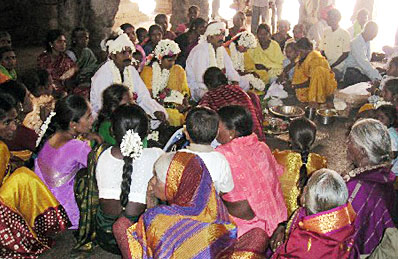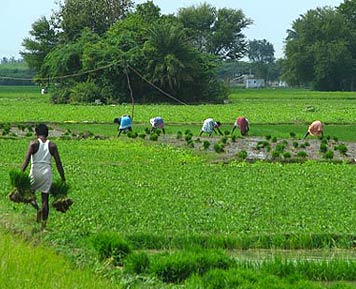The villages of Punjab are rich in tradition and cultural heritage. A majority of the state`s total population lives in the villages. The villagers live a life full of joy and entertainment and they celebrate each and every occasion together. Music and dance play a major part in their celebrations. The Punjabi style of celebration is famous all over the world. The villages of Punjab are also considered the lifeline for the state, as their economic, agricultural or industrial strength largely depend upon the villages.
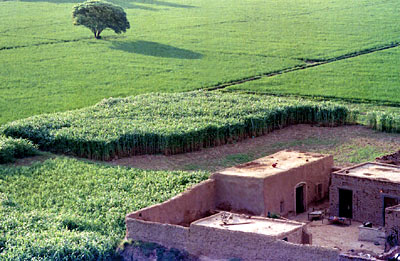 Society in the villages of Punjab is a mixture of a variety of religious communities. People follow different religious paths and also celebrate their respective fairs and festivals. The major religious communities living in the villages of Punjab include the Muslims, Hindus, Sikhs, Jains, Buddhists, etc. Apart from these, various tribal communities also reside in the villages of Punjab. The major tribes of Punjab include the Jats, Khatris, Aroras, Brahmans, Vaishas, Sainis, Kambohs, Sansis, etc. The Sainis mainly reside in the villages located in Jalandhar, Hoshiarpur, Gurdaspur, Rupar, etc. and the Kambohs reside in the villages of Patiala, Jalandhar, Kapurthala, Amritsar, Ferozepur, etc. All these tribes are dependent on agriculture and hence, are known as agriculturist tribes. However, there are a few non-agriculturist tribes found in the villages of Punjab. These tribes include the Khatris, the Aroras and the Vaishas and they are mainly engaged in trade and commerce.
Society in the villages of Punjab is a mixture of a variety of religious communities. People follow different religious paths and also celebrate their respective fairs and festivals. The major religious communities living in the villages of Punjab include the Muslims, Hindus, Sikhs, Jains, Buddhists, etc. Apart from these, various tribal communities also reside in the villages of Punjab. The major tribes of Punjab include the Jats, Khatris, Aroras, Brahmans, Vaishas, Sainis, Kambohs, Sansis, etc. The Sainis mainly reside in the villages located in Jalandhar, Hoshiarpur, Gurdaspur, Rupar, etc. and the Kambohs reside in the villages of Patiala, Jalandhar, Kapurthala, Amritsar, Ferozepur, etc. All these tribes are dependent on agriculture and hence, are known as agriculturist tribes. However, there are a few non-agriculturist tribes found in the villages of Punjab. These tribes include the Khatris, the Aroras and the Vaishas and they are mainly engaged in trade and commerce. The rural people in Punjab speak in different languages. However, Punjabi is the most widely spoken language in the villages of Punjab. Apart from Punjabi, the other major languages include Hindi, Urdu, English, etc. Other dialects are also spoken by the people in Punjab. Some of the most common dialects are Awankari, Bhattiani, Rathi, Malwai, Powadhi, Pahari, Doabi, Kangri, Dogri, Jangli, Jatki, Chenavri, Bhawalpuri, Thali, Bherochi, Dhani, Ghebi, Hindko, Swaen, Chacchi, Pothohari, Punchi, etc.
The governmental authorities have established many primary and secondary schools in the villages of Punjab to provide the villagers with primary and secondary education. Most children in the villages receive primary education from these schools. The number of school going children in the villages of Punjab is quite remarkable. After completing the 10+2 education, the students can pursue higher education in the colleges and universities located in the urban areas. The overall educational scenario in the villages of Punjab is impressive. However, continuous initiatives are being taken by the governmental authorities to further improve the status of rural education.
Agriculture has always been the principal occupation of people in the villages of Punjab. Punjab is one of the most agriculturally developed regions in India and contributes hugely to the total agricultural production of India. There are two main harvests in a year in the villages, namely the Rabi or spring and the Kharif. The villagers cultivate the crops like wheat, gram, barley, oil seeds, fodder crops, potatoes, winter vegetables, etc. during the Rabi season. On the other hand, the Kharif or autumn harvest consists of the crops like rice, maize, sugarcane, cotton, pulses, gram and peas, bajra, jowar and the vegetables like chillies, onions, gourd, etc. The villagers practice two system of cropping namely the Dofasli Harsala and Ekfasli Harsala. While, the Dofasli Harsala means two harvests in a period of twelve months, the Ekfasli Harsala means a single crop in a year.
Apart from agriculture, various small-scale and medium scale industries also provide employment in the villages of Punjab. The small-scale industrial units in Punjab produce bicycle parts, sewing machines, hand tools, machine tools, auto parts, electronic items, sports goods, hosiery, knitwear, textiles, sugar, surgical and leather goods, etc. Most of these products manufactured in the villages of Punjab are at par with the highest quality standards in the world. The other industries providing employment to the villagers in Punjab include the cotton textile industry, sugar industry, dairy industry, Vanaspati ghee industry, woolen textile industry, hosiery industry, sports goods industry, engineering industries, etc.
People in the villages of Punjab are famous all over the country for their wonderful way of celebrating various fairs and festivals. All the festivals celebrated in Punjab are colourful in nature and people perform various traditional music and dance forms as part of celebrating festivals. The major festivals celebrated in the villages of Punjab include Holi, Baisakhi, Lohri, Maghi, Diwali, Gurparav, Tika, Teej, Basant Panchami, etc. People perform the popular dance forms like Bhangra, Dhamal, Gidda, Sammi, Jhumar, Jaago, Luddi, Kikli, Julli, Teeyan, etc. during the festivals. The villagers also wear their traditional dresses during the festivals. The traditional dresses for men include the turban, kurta, pyjama, loose baggy salwar, loongi or tehmat, the juttis (shoes), etc. On the other hand, the traditional attires for Punjabi women include salwar-kameez, kurta, chunni or dupatta, etc. There is a particular kind of bangle worn by both Sikh men and women in the villages of Punjab named Kada. Many villagers also use a range of ornaments including bangles, necklaces, rings and earrings, nose-pins, ornaments to pin in the hair, anklets, toe-rings, etc.
Various traditional rural sports also play a major part in celebration of festivals in the villages of Punjab. Generally, three types of sport competitions are held during rural fairs and festivals including the purely rural games like kabaddi, wrestling, weight-lifting, etc. The modern sports like hockey, football, volleyball, cycling, handball, etc. are also organised during village festivals. Apart from these, the performing sports like acrobatics, passing tractor over the rib-ease, twisting an iron-rod by placing it on Adam`s apple, cracking a big stone by placing it on the chest, etc. are held as well. The most frequently played sports in the villages of Punjab include running, jumping, archery, fencing and riding competitions, gymnastic and acrobatic displays, hockey, Tirinjen, Kikli, Gheeta Pathar, Khidu, Kokla Chhapaki, Chicho Chich Ganerian, Lukan Miti (Hide & Seek), Guli Danda, Kidi Kada or Stapoo, Ghaggar Phissi, Rasa Kashi (Tug of War), Martial Art, Kite Flying (Patang Bazi), etc.
The villages of Punjab are a favourite tourist destination for many people in India. They love to visit the villages to experience the wonderful Punjabi way of celebrating festivals. The lush green paddy fields and wonderful scenic beauty of the villages also attracts many people from all over the country.


 The South Indian villages are famous all over the country for their glittering festivals and their wonderful ways of celebrating these festivals. The south Indian village festivals are of different kinds like religious, or seasonal or related to harvesting. While some of the festivals are just agrarian and pastoral in nature, others are connected with mythology. There are also a few sports festivals celebrated in the villages of south India. The south Indian villages comprise the villages located in the states of Kerala, Karnataka, Tamil Nadu, Andhra Pradesh, etc.
The South Indian villages are famous all over the country for their glittering festivals and their wonderful ways of celebrating these festivals. The south Indian village festivals are of different kinds like religious, or seasonal or related to harvesting. While some of the festivals are just agrarian and pastoral in nature, others are connected with mythology. There are also a few sports festivals celebrated in the villages of south India. The south Indian villages comprise the villages located in the states of Kerala, Karnataka, Tamil Nadu, Andhra Pradesh, etc.  Pongal festival is counted amongst the most famous and popular south Indian village festivals. This harvest festival is mainly celebrated in the villages of Tamil Nadu and it has three days duration. The three days of the festival have different names like Bhogi (first day), Pongal (second day) and Mattu Pongal (third day). The villagers wear new clothes and decorate their houses with beautiful motifs using rice flower during the Pongal festival. Pongal is actually the name of the sweet made of the first rice. Float festival is also an important south Indian village festival. The villagers embellish the icons of goddess Meenakshi and after taking her consort in a colourful procession, they float the icons in the tank of a raft decked with flowers and lamps.
Pongal festival is counted amongst the most famous and popular south Indian village festivals. This harvest festival is mainly celebrated in the villages of Tamil Nadu and it has three days duration. The three days of the festival have different names like Bhogi (first day), Pongal (second day) and Mattu Pongal (third day). The villagers wear new clothes and decorate their houses with beautiful motifs using rice flower during the Pongal festival. Pongal is actually the name of the sweet made of the first rice. Float festival is also an important south Indian village festival. The villagers embellish the icons of goddess Meenakshi and after taking her consort in a colourful procession, they float the icons in the tank of a raft decked with flowers and lamps. 

 The villages in east India are rich in tradition and their cultural heritage. They are famous for celebrating a variety of vibrant festivals throughout the year. The East Indian village festivals are celebrated with much pomp and cheerfulness and are considered some of the greatest events to enjoy. The villagers take these festivals as a platform for social communication and also as a way to get relief from the stress of their daily life. The villages in the states of West Bengal, Bihar, Orissa and Assam can be clubbed into the term `East Indian villages`.
The villages in east India are rich in tradition and their cultural heritage. They are famous for celebrating a variety of vibrant festivals throughout the year. The East Indian village festivals are celebrated with much pomp and cheerfulness and are considered some of the greatest events to enjoy. The villagers take these festivals as a platform for social communication and also as a way to get relief from the stress of their daily life. The villages in the states of West Bengal, Bihar, Orissa and Assam can be clubbed into the term `East Indian villages`.  The festivals of Bihar are counted amongst the most notable East Indian village festivals. People in the villages of Bihar celebrate various festivals that can be classified as religious or seasonal and some of them are related to harvesting. Chhath Puja is one of the major religious festivals celebrated in the East Indian villages. The villagers worship the setting sun during Chhath Puja. It is celebrated twice in a year, once in the Bengali month of Chaitra and the other is in Kartik. Sama-Chakeva is another important village festival in east India. The celebration of this festival is done in the winter season with the arrival of colourful birds from Himalayas that migrate towards the plains. Apart from these, the other major festivals celebrated in the villages of east India include Ramnavami, Makar-Sankranti (also known as Tila Sankranti), Bihula, Madhushravani, Basant Panchami, etc.
The festivals of Bihar are counted amongst the most notable East Indian village festivals. People in the villages of Bihar celebrate various festivals that can be classified as religious or seasonal and some of them are related to harvesting. Chhath Puja is one of the major religious festivals celebrated in the East Indian villages. The villagers worship the setting sun during Chhath Puja. It is celebrated twice in a year, once in the Bengali month of Chaitra and the other is in Kartik. Sama-Chakeva is another important village festival in east India. The celebration of this festival is done in the winter season with the arrival of colourful birds from Himalayas that migrate towards the plains. Apart from these, the other major festivals celebrated in the villages of east India include Ramnavami, Makar-Sankranti (also known as Tila Sankranti), Bihula, Madhushravani, Basant Panchami, etc.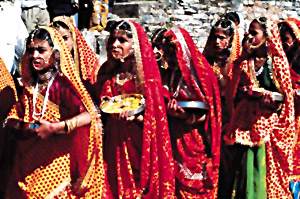
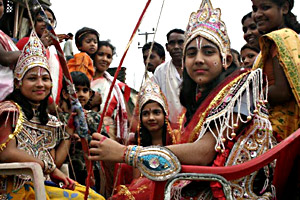 Central India Village Festivals
Central India Village Festivals After Independence, the administration in Indian villages partially went back to the administrative structure followed during the ancient period. The Government of India decided to implement the local self-government system in all the villages of India where the villages would be governed by a Panchayat Committee. This committee was somewhat identical to the Gram Sabha. The difference is that the members in the Panchayat Committee are elected democratically through general elections and the adult villagers cast their votes to put their favourite person into the Committee. The Panchayat Committee looks after all kinds of issues related to the village and also tries to establish law and order in the village. In contemporary India, the Panchayat Committees are constitutional bodies that enjoy autonomy in most of its activities. However, they are subject to contact the State Governments in certain issues and they actually work under the supervision of the State Governments.
After Independence, the administration in Indian villages partially went back to the administrative structure followed during the ancient period. The Government of India decided to implement the local self-government system in all the villages of India where the villages would be governed by a Panchayat Committee. This committee was somewhat identical to the Gram Sabha. The difference is that the members in the Panchayat Committee are elected democratically through general elections and the adult villagers cast their votes to put their favourite person into the Committee. The Panchayat Committee looks after all kinds of issues related to the village and also tries to establish law and order in the village. In contemporary India, the Panchayat Committees are constitutional bodies that enjoy autonomy in most of its activities. However, they are subject to contact the State Governments in certain issues and they actually work under the supervision of the State Governments.  In the contemporary period, the status of women in Indian villages is quite impressive. The women can now participate in all types of activities like education, politics, media, art and culture, service sectors, science and technology, etc. The women are also taking part in many social movements like anti-liquor movement or anti-molestation movement. The women in Indian villages have many chances of getting education and they go to the government primary schools in numbers. As a result, the women literacy rate in the villages of India has increased significantly in the recent years.
In the contemporary period, the status of women in Indian villages is quite impressive. The women can now participate in all types of activities like education, politics, media, art and culture, service sectors, science and technology, etc. The women are also taking part in many social movements like anti-liquor movement or anti-molestation movement. The women in Indian villages have many chances of getting education and they go to the government primary schools in numbers. As a result, the women literacy rate in the villages of India has increased significantly in the recent years.  After the independence of India, education in Indian villages witnessed another massive change. The Government of India followed the education system set up by the British to a large extent and established new government schools in the villages. The government viewed rural education as an effective tool for bringing social change through community development. More emphasis was laid on primary education up to the age of 14 years and as a result, many new schools were established in the villages. The children in villages get their primary education from the government primary schools. They are taught various subjects including the languages, mathematics, science subjects, arts subjects, agricultural subjects, housekeeping subjects, etc. The elementary education of eight years has also been made compulsory and free for the children in the villages of India. Apart from that, the government authorities have taken many more steps to further improve the status of education in Indian villages as well.
After the independence of India, education in Indian villages witnessed another massive change. The Government of India followed the education system set up by the British to a large extent and established new government schools in the villages. The government viewed rural education as an effective tool for bringing social change through community development. More emphasis was laid on primary education up to the age of 14 years and as a result, many new schools were established in the villages. The children in villages get their primary education from the government primary schools. They are taught various subjects including the languages, mathematics, science subjects, arts subjects, agricultural subjects, housekeeping subjects, etc. The elementary education of eight years has also been made compulsory and free for the children in the villages of India. Apart from that, the government authorities have taken many more steps to further improve the status of education in Indian villages as well. 